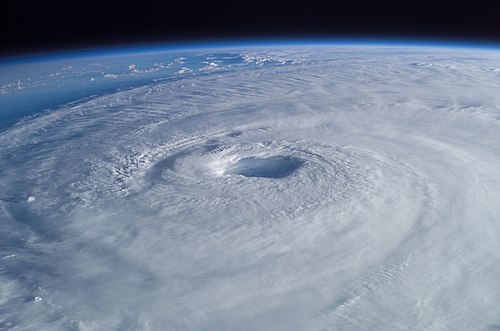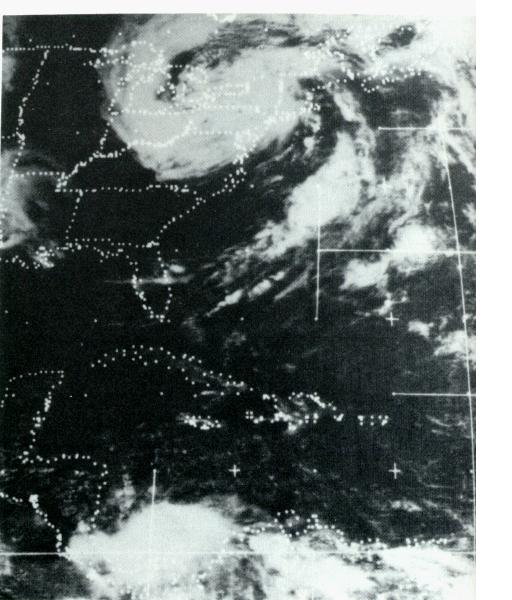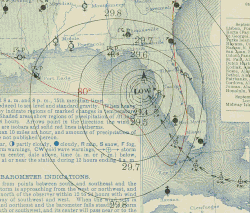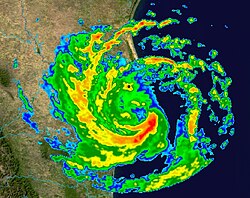The Tropical Cyclones Portal

A tropical cyclone is a storm system characterized by a large low-pressure center, a closed low-level circulation and a spiral arrangement of numerous thunderstorms that produce strong winds and heavy rainfall. Tropical cyclones feed on the heat released when moist air rises, resulting in condensation of water vapor contained in the moist air. They are fueled by a different heat mechanism than other cyclonic windstorms such as Nor'easters, European windstorms and polar lows, leading to their classification as "warm core" storm systems. Most tropical cyclones originate in the doldrums, approximately ten degrees from the Equator.
The term "tropical" refers to both the geographic origin of these systems, which form almost exclusively in tropical regions of the globe, as well as to their formation in maritime tropical air masses. The term "cyclone" refers to such storms' cyclonic nature, with anticlockwise rotation in the Northern Hemisphere and clockwise rotation in the Southern Hemisphere. Depending on its location and intensity, a tropical cyclone may be referred to by names such as "hurricane", "typhoon", "tropical storm", "cyclonic storm", "tropical depression" or simply "cyclone".
Types of cyclone: 1. A "Typhoon" is a tropical cyclone located in the North-west Pacific Ocean which has the most cyclonic activity and storms occur year-round. 2. A "Hurricane" is also a tropical cyclone located at the North Atlantic Ocean or North-east Pacific Ocean which have an average storm activity and storms typically form between May 15 and November 30. 3. A "Cyclone" is a tropical cyclone that occurs in the South Pacific and Indian Oceans.
Selected named cyclone -
Cyclone Ianos, also known as Medicane Ianos, was a rare medicane that impacted the eastern Mediterranean on 17 and 18 September 2020, especially Greece. Ianos developed from an area of low pressure over the Gulf of Sidra that quickly began tropical cyclogenesis while moving over warm waters. After receiving various names from different meteorological centers, the storm, dubbed Ianos by the METEO unit of the National Observatory of Athens, rapidly intensified while moving northeastward. After scraping Italy, the storm went on to strike Malta and Crete with tropical storm-force winds. Despite land interaction, the small cyclone reached its peak intensity of 159 km/h (99 mph) with wind gusts up to 195 km/h (121 mph) on 18 September, equivalent to a Category 2 hurricane on the Saffir–Simpson scale, immediately before making landfall in southwestern Greece. After landfall, Ianos turned back out to sea and moved south-southeastward, before dissipating on 21 September.
Damage was severe in Greece, with cities in the central part of the country getting the brunt of the storm's impacts. Cities such as Karditsa and Mouzaki were flooded for several days. Heavy agricultural damage was reported in rural areas north of Athens. A state of emergency was declared for the islands of Ithaca, Kefalonia, and Zakynthos. Four people were killed, and one person remains missing. Ianos caused at least $100 million (2020 USD) in damages. (Full article...)
Selected article -
Hurricane Gordon developed during a fourteen-day period along an erratic, persistent, and highly unusual path. The hurricane formed near Panama in the southwestern Caribbean on November 8, 1994. As a tropical depression, it brushed Nicaragua and spent several days in the waters off the country's coast. Strengthening slightly into a tropical storm, Gordon wound its way north into the Greater Antilles. Despite warm waters, persistent wind shear prevented significant strengthening. Executing a slow turn to the north and then the northwest, Gordon made two more landfalls, on eastern Jamaica and eastern Cuba, while delivering tremendous rains to western Hispaniola.
As Gordon made its fourth landfall crossing the Florida Keys, it interacted with a cyclone in the upper-troposphere and a series of cyclonic lows which lent the storm some sub-tropical characteristics. After a few days as an unusual hybrid of a tropical and a subtropical system in the Gulf of Mexico, the storm re-claimed its fully tropical form and made yet another landfall, this time across the Florida peninsula, and continued into the Atlantic Ocean. In the Atlantic, Gordon rapidly strengthened to a Category 1 hurricane. Gordon's characteristic wandering briefly brought it near North Carolina, but ultimately the storm headed south, weakening into a minor tropical storm before making its sixth and final landfall on Florida's east coast. (Full article...)
Selected image -

Selected season -

The 1983 Atlantic hurricane season was the least active Atlantic hurricane season in the satellite era and the least active overall since 1930. The season officially began on June 1, 1983, and lasted until November 30, 1983. These dates conventionally delimit the period of each year when most storms form in the Atlantic basin. The season had very little activity, with only seven tropical depressions, four of which reached tropical storm strength or higher. This led to the lowest accumulated cyclone energy count since 1977.
The season began later than normal; the first tropical depression formed on July 23 and the second on July 27. Neither tropical depressions strengthened and they dissipated soon thereafter. Hurricane Alicia formed as Tropical Depression Three on August 15, quickly intensified into a hurricane on August 16 and made landfall in Texas on August 18. Alicia caused $3 billion in damage in Texas. Hurricane Barry formed on August 25, crossed Florida and strengthened into a hurricane. Barry made landfall near the Mexico–United States border, and dissipated over land on August 30. (Full article...)
Related portals
Currently active tropical cyclones

Italicized basins are unofficial.
- North Atlantic (2025)
- No active systems
- Mediterranean (2025–26)
- No active systems
- South-West Indian Ocean (2025–26)
- No active systems
- Australian region (2025–26)
- No active systems
- South Pacific (2025–26)
- No active systems
- South Atlantic (2025–26)
- No active systems
Last updated: 06:19, 6 October 2025 (UTC)
Tropical cyclone anniversaries

October 5
- 1864 - The 1864 Calcutta cyclone hit India near Calcutta, devastating the city and killing about 60,000 people.
- 1999 - Typhoon Dan reaches its maximum intensity as a Category 3 typhoon with 10-minute sustained winds of 150 km/h (90 mph)
- 2003 - Tropical Storm Larry (pictured) makes landfall over in Paraíso, Tabasco. Damages from Larry were recorded at $53.6 million.

October 6
- 1973 - Typhoon Nora reached its peak intensity with 295 km/h (185 mph) winds in the Philippine Sea. Nora made landfall in northeast Luzon a few days later, causing $2 billion of damage.
- 1989 - Typhoon Angela makes landfall over in northern Luzon, Philippines and killing a total of 119.
- 2013 - Typhoon Fitow (pictured) makes landfall in Fujian, causing $10.4 billion in damages, making it the third costliest typhoon on record.

October 7
- 1737 - The 1737 Calcutta cyclone hit Calcutta, India killing at least 3,000 people. Until recently, it was thought that this natural disaster was an earthquake and not a tropical cyclone.
- 2008 - Tropical Storm Marco, recognized as the smallest tropical cyclone on record, makes landfall over in Veracruz, Mexico, where it also dissipated in the same day, only causing minimal damages.
- 2024 - Hurricane Milton (pictured) reaches peak intensity north of Mexico's Yucatán Peninsula. It later hit Florida, producing a deadly tornado outbreak and causing billions in damage.
Did you know…



- …that the Australian region have three distinct lists of names for tropical storms, each one of them being administered by agencies in Autralia, Indonesia and Papua New Guinea, respectively?
- …that the Joint Typhoon Warning Center considers that Typhoon Vera (pictured) of 1986 is actually two distinct systems, formed from two separated low-level circulations?
- …that Cyclone Freddy (track pictured) in 2023 was the longest-lasting tropical cyclone recorded?
- …that the typhoons of 2024—Yinxing, Toraji, Usagi, and Man-yi (pictured)—made history as the first recorded instance since 1951 of four tropical cyclones coexisting in November?
General images -

The list of North Carolina hurricanes from 1980 to 1999 encompasses approximately 68 tropical or subtropical cyclones that affected the U.S. state of North Carolina. Collectively, cyclones in North Carolina during the time period resulted in around $10 billion in damage (2007 USD), primarily from hurricanes Fran and Floyd. Additionally, tropical cyclones in North Carolina were responsible for about 56 direct fatalities and at least 47 indirect casualties during the period. Eight cyclones affected the state in the 1985 season, which was the year with the most tropical cyclones impacting the state. Every year included at least one tropical cyclone affecting the state. All but two storms were North Atlantic hurricanes; the exceptions were Eastern Pacific hurricanes Tico in 1983 and Roslyn in 1986.
The strongest hurricane to hit the state during the time period was Hurricane Fran in 1996, which struck near Wilmington as a Category 3 hurricane on the Saffir–Simpson hurricane scale; Hurricane Emily in 1993 brushed the Outer Banks also as a Category 3 hurricane. The deadliest hurricane during the period was Hurricane Floyd in 1999, which caused 35 fatalities and record-breaking flooding in the eastern portion of the state. Cyclones affected the state in each month of the hurricane season from June to November, primarily in September. (Full article...)
Topics
Subcategories
Related WikiProjects
WikiProject Tropical cyclones is the central point of coordination for Wikipedia's coverage of tropical cyclones. Feel free to help!
WikiProject Weather is the main center point of coordination for Wikipedia's coverage of meteorology in general, and the parent project of WikiProject Tropical cyclones. Three other branches of WikiProject Weather in particular share significant overlaps with WikiProject Tropical cyclones:
- The Non-tropical storms task force coordinates most of Wikipedia's coverage on extratropical cyclones, which tropical cyclones often transition into near the end of their lifespan.
- The Floods task force takes on the scope of flooding events all over the world, with rainfall from tropical cyclones a significant factor in many of them.
- WikiProject Severe weather documents the effects of extreme weather such as tornadoes, which landfalling tropical cyclones can produce.
Things you can do
 |
Here are some tasks awaiting attention:
|
Wikimedia
The following Wikimedia Foundation sister projects provide more on this subject:
-
Commons
Free media repository -
Wikibooks
Free textbooks and manuals -
Wikidata
Free knowledge base -
Wikinews
Free-content news -
Wikiquote
Collection of quotations -
Wikisource
Free-content library -
Wikiversity
Free learning tools -
Wikivoyage
Free travel guide -
Wiktionary
Dictionary and thesaurus





































